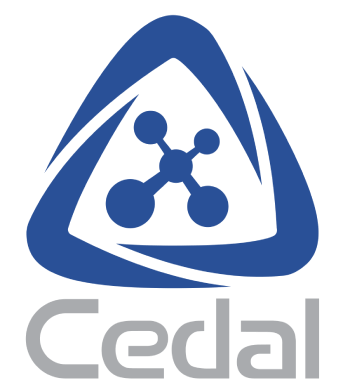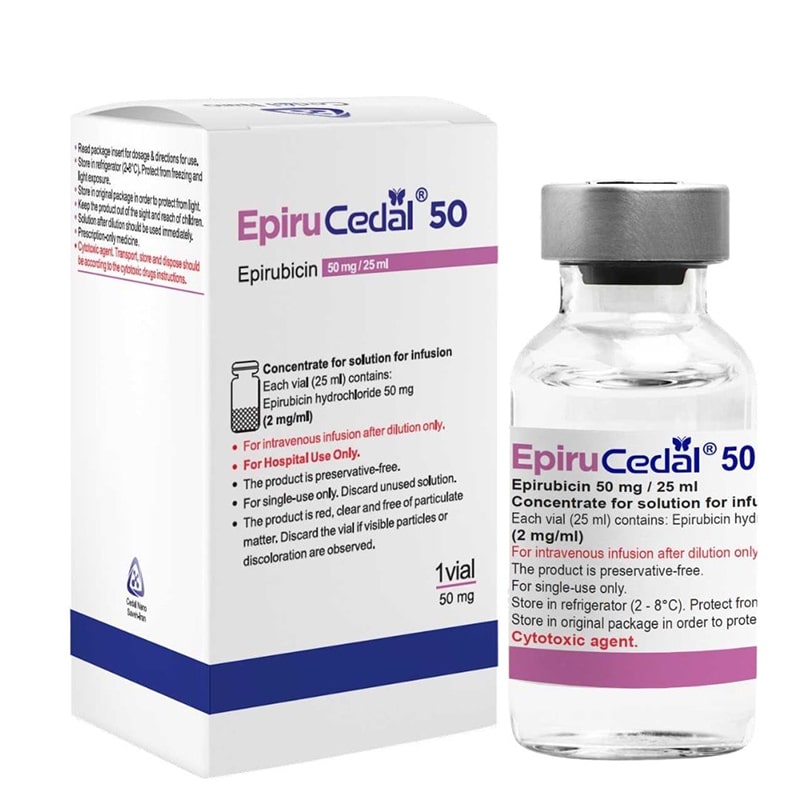Administer Epirucedal® only under the supervision of qualified physicians experienced in the use of cytotoxic therapy. Before beginning treatment with Epirucedal®, patients should recover from acute toxicities (such as stomatitis, neutropenia, thrombocytopenia and generalized infections) of prior cytotoxic treatment. Also, precede initial treatment with Epirucedal® by a careful baseline assessment of blood counts,serum levels of total bilirubin, AST, creatinine and cardiac function as measured by left ventricular ejection function (LVEF). Carefully monitor patients during treatment for possible clinical complications due to myelosuppression. Supportive care may be necessary for the treatment of severe neutropenia and severe infectious complications. Monitoring for potential cardiotoxicity is also important, especially with greater cumulative exposure to Epirucedal®.
Injection-Related Reactions:
Epirucedal® is administered by intravenous infusion. Venous sclerosis may result from an injection into a small vessel or from repeated injections into the same vein. Extravasation of Epirucedal® during the infusion may cause local pain, severe tissue lesions (vesication, severe cellulitis) and necrosis. Administer Epirucedal® slowly into the tubing of a freely running intravenous infusion. Patients receiving initial therapy at the recommended starting doses of 100-120 mg/m2 should generally have Epirucedal® infused over 15-20 minutes. For patients who require lower Epirucedal® starting doses due to organ dysfunction or who require modification of Epirucedal® doses during therapy, the Epirucedal® infusion time may be proportionally decreased, but should not be less than 3 minutes. If possible, avoid veins over joints or in extremities with compromised venous or lymphatic drainage. Immediately terminate infusion and restart in another vein if a burning or stinging sensation indicates perivenous infiltration. Perivenous infiltration may occur without causing pain. Facial flushing, as well as local erythematous streaking along the vein may be indicative of excessively rapid administration. It may precede local phlebitis or thrombophlebitis. Give prophylactic antibiotic therapy to patients administered the 120 mg/m2 regimen of Epirucedal® as a component of combination chemotherapy.
Hematologic:
Epirucedal® can suppress bone marrow function as manifested by leukopenia, thrombocytopenia and anaemia. myelosuppression is usually the dose-limiting toxicity. Patients should be monitored for myelosuppression during therapy.
Cardiac:
Cardiotoxicity is a known risk of anthracycline treatment. Anthracycline-induced cardiac toxicity may be manifested by early (or acute) or late (delayed) events. Early cardiac toxicity of Epirucedal® consists mainly of sinus tachycardia and/or electrocardiogram (ECG) abnormalities such as non-specific ST-T wave changes, but tachyarrhythmias, including premature ventricular contractions and ventricular tachycardia, bradycardia, as well as atrioventricular and bundle-branch block have also been reported. These effects do not usually predict subsequent development of delayed cardiotoxicity are rarely of clinical importance, and are generally not considered an indication for the suspension of Epirucedal® treatment. Delayed cardiac toxicity results from a characteristic cardiomyopathy that is manifested by reduced LVEF and/or signs and symptoms of congestive heart failure (CHF) such as tachycardia, dyspnea, pulmonary edema, dependent edema, hepatomegaly, ascites, pleural effusion, gallop rhythm. Life-threatening CHF is the most severe form of anthracycline-induced cardiomyopathy. This toxicity appears to be dependent on the cumulative dose of Epirucedal® and represents the cumulative dose-limiting toxicity of the drug. If it occurs, delayed cardiotoxicity usually develops late in the course of therapy with Epirucedal® or within 2 to 3 months after completion of treatment, but later events (several months to years after treatment termination) have been reported.
Given the risk of cardiomyopathy, exceed a cumulative dose of 900 mg/m2 Epirucedal® only with extreme caution. Risk factors [active or dormant cardiovascular disease, prior or concomitant radiotherapy to the mediastinal/pericardial area, previous therapy with other anthracyclines or anthracenediones, concomitant use of other drugs with the ability to suppress cardiac contractility or cardiotoxic drugs, especially those with long half-lives (e.g., trastuzumab)] may increase the risk of Epirucedal® cardiotoxicity.
Although not formally tested, it is probable that the toxicity of Epirucedal® and other anthracyclines or anthracenediones is additive. Cardiac toxicity with Epirucedal® may occur at lower cumulative doses whether cardiac risk factors are present.
Although endomyocardial biopsy is recognized as the most sensitive diagnostic tool to detect anthracycline-induced cardiomyopathy, this invasive examination is not practically performed on a routine basis. ECG changes such as dysrhythmias, a reduction of the QRS voltage, or a prolongation beyond normal limits of the systolic time interval may be indicative of anthracycline-induced cardiomyopathy, but ECG is not a sensitive or specific method for following anthracycline-related cardiotoxicity. The risk of serious cardiac impairment may be decreased through regular monitoring of LVEF during the course of treatment with prompt discontinuation of Epirucedal® at the first sign of impaired function. The preferred method for repeated assessment of cardiac function is evaluation of LVEF measured by multi-gated radionuclide angiography (MUGA) or echocardiography (ECHO). A baseline cardiac evaluation with an ECG and a MUGA scan or an ECHO is recommended, especially in patients with risk factors for increased cardiac toxicity. Perform repeated MUGA or ECHO determinations of LVEF, particularly with higher, cumulative anthracycline doses. The technique used for assessment should be consistent through follow-up. In patients with risk factors, particularly prior anthracycline or anthracenedione use, the monitoring of cardiac function must be particularly strict and the risk-benefit of continuing treatment with Epirucedal® in patients with impaired cardiac function must be carefully evaluated.
Do not administer Epirucedal® in combination with other cardio toxic agents unless the patient’s cardiac function is closely monitored. Patients receiving Epirucedal® after stopping treatment with other cardiotoxic agents, especially those with long half-lives such as trastuzumab, may also be at an increased risk of developing cardiotoxicity.
Secondary Leukemia:
The occurrence of secondary acute myelogenous leukemia, with or without a pre leukemic phase, has been reported in patients treated with anthracyclines. Secondary leukemia is more common when such drugs are given in combination with DNA-damaging antineoplastic agents, when patients have been heavily pretreated with cytotoxic drugs, or when doses of the anthracyclines have been escalated. These leukemias can have a short 1-3 year latency period. Epirubicin is mutagenic, clastogenic and carcinogenic in animals.
Hepatic:
The major route of elimination of epirubicin is the hepatobiliary system. Evaluate serum total bilirubin and AST levels before and during treatment with Epirucedal®. Patients with elevated bilirubin or AST may experience slower clearance of drug with an increase in overall toxicity. Lower doses are recommended in these patients. Patients with severe hepatic impairment have not been evaluated; therefore, do not use Epirucedal® in this patient population.
Renal:
Assess serum creatinine before and during therapy. Dosage adjustment is necessary in patients with serum creatinine >5 mg/dL. Patients undergoing dialysis have not been studied.
Tumor-Lysis Syndrome:
As with other cytotoxic agents, Epirucedal® may induce hyperuricemia as a consequence of the extensive purine catabolism that accompanies drug-induced rapid lysis of highly chemosensitive neoplastic cells (tumor-lysis syndrome). Other metabolic abnormalities may also occur. While not generally a problem in patients with breast cancer, consider the potential for tumor-lysis syndrome in potentially susceptible patients and consider monitoring serum uric acid, potassium, calcium, phosphate and creatinine immediately after initial chemotherapy administration.
Hydration, urine alkalinization and prophylaxis with allopurinol to prevent hyperuricemia may minimize potential complications of tumor-lysis syndrome.
Immunosuppressant Effects/Increased Susceptibility to Infections:
Administration of live or live-attenuated vaccines in patients immunocompromised by chemotherapeutic agents including epirubicin, may result in serious or fatal infections. Avoid vaccination with a live vaccine in patients receiving Epirucedal®. Killed or inactivated vaccines may be administered; however, the response to such vaccines may be diminished.
Gastrointestinal:
Epirucedal® is emetogenic. Antiemetics may reduce nausea and vomiting; prophylactic use of antiemetics should be considered before administration of Epirucedal®, particularly when given in conjunction with other emetogenic drugs.
Thrombophlebitis and Thromboembolic Phenomena:
As with other cytotoxic agents, thrombophlebitis and thromboembolic phenomena, including pulmonary embolism (in some cases fatal) have been coincidentally reported with the use of Epirucedal®.
Coadministration with Cimetidine:
Cimetidine increased the AUC of epirubicin by 50%. Stop Cimetidine treatment during treatment with Epirucedal®.
Pregnancy:
Epirucedal® can cause fetal harm when administered to a pregnant woman. Epirubicin was embryolethal and teratogenic in rats and rabbits. There are no adequate and well-controlled studies of Epirucedal® in pregnant women. If this drug is used during pregnancy, or if the patient becomes pregnant while taking this drug, the patient should be apprised of the potential hazard to a fetus. Women of child-bearing potential should be advised to avoid becoming pregnant during treatment and should use effective contraceptive methods.
Male Fertility and Reproductive Outcomes:
Males with female sexual partners of childbearing potential should use contraception during and after cessation of Epirucedal® therapy. Epirucedal® may damage testicular tissue and spermatozoa. Possible sperm DNA damage raises concerns about loss of fertility and genetic abnormalities in fetuses. The duration of this effect is uncertain.
Laboratory Testing:
Assess blood counts, including absolute neutrophil counts and liver function, before and during each cycle of therapy with Epirucedal®. Perform repeated evaluations of LVEF during therapy.
Inflammation following Irradiation:
As with other anthracyclines, administration of Epirucedal® after previous radiation therapy may induce an inflammatory recall reaction at the site of the irradiation.


